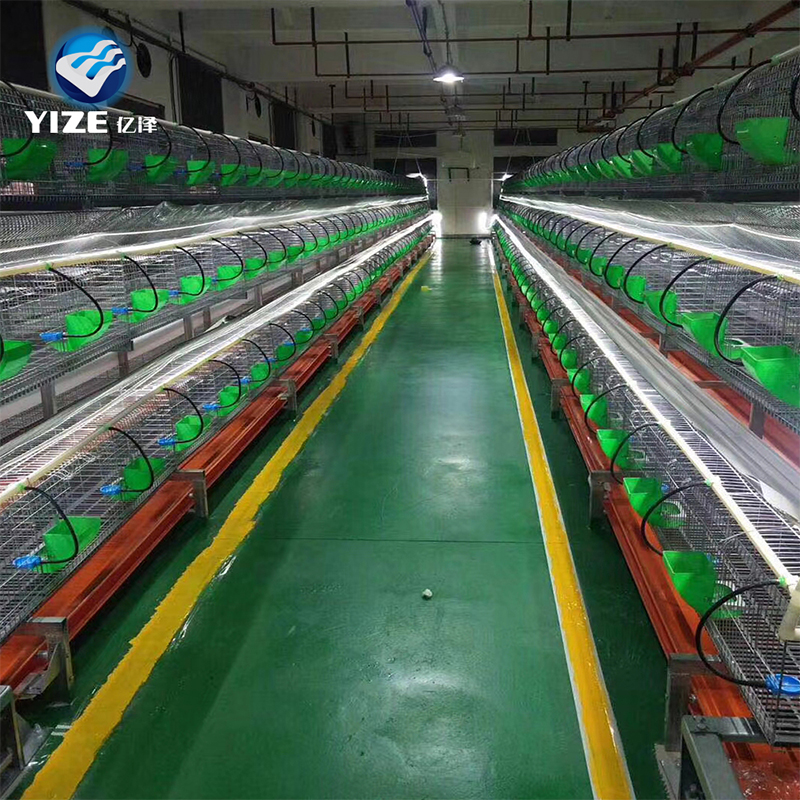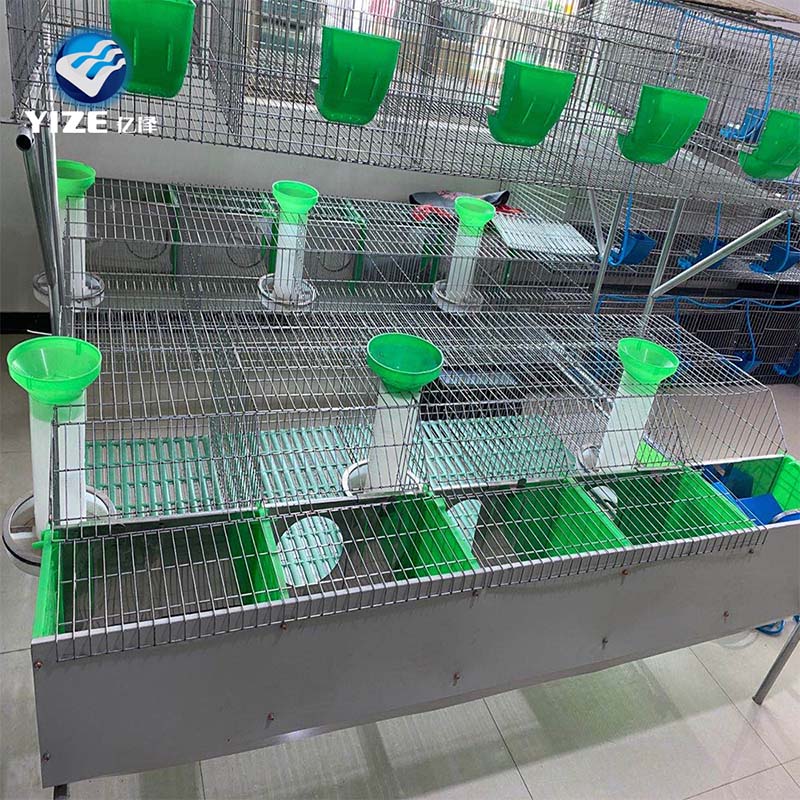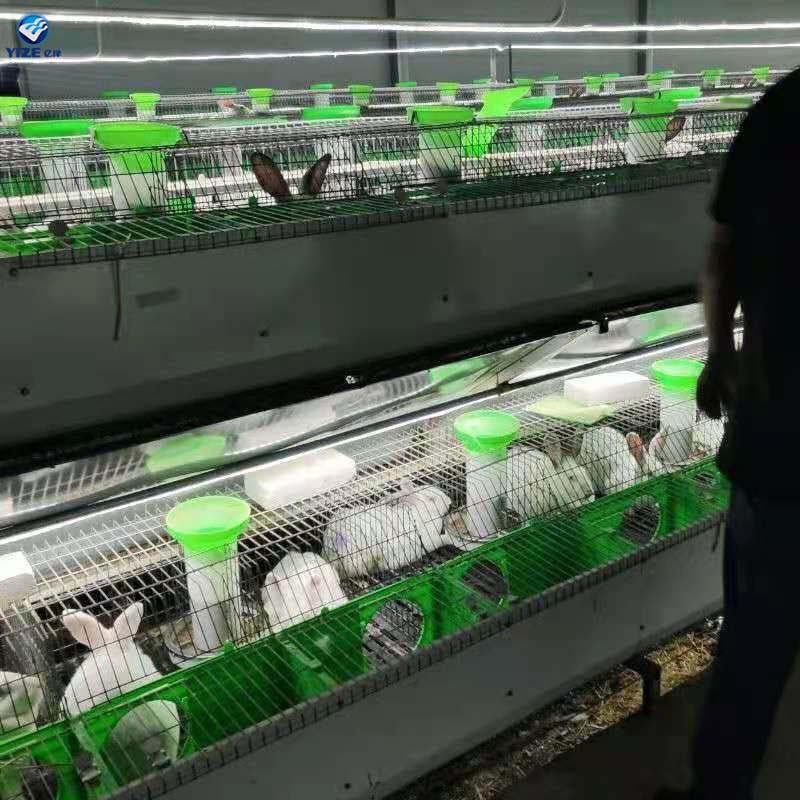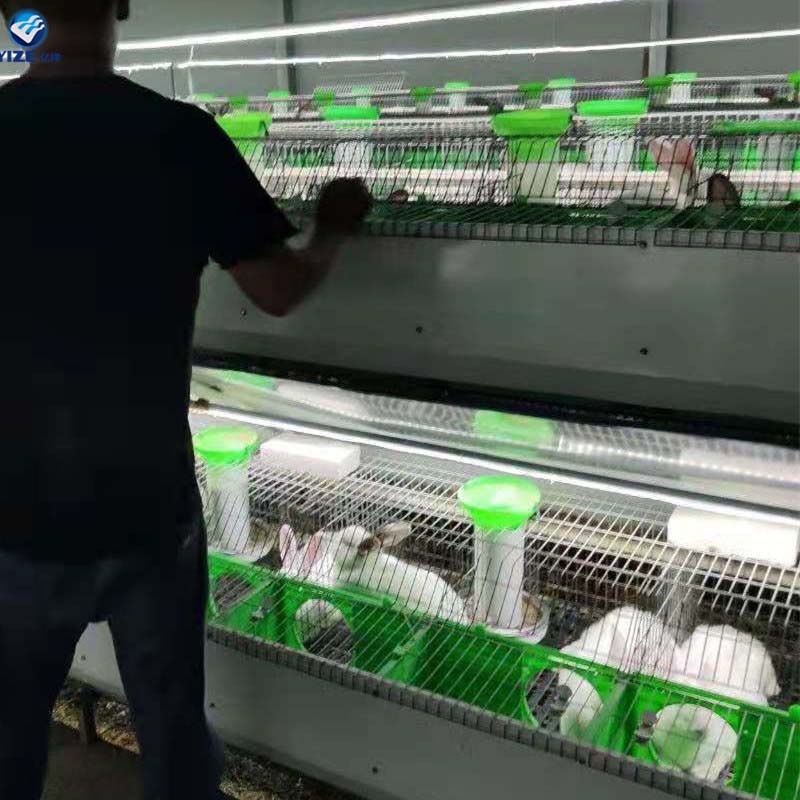Commercial Rabbit Cages | European Design for Breeding Success
សីហា . 25, 2025 02:00 Back to list
Commercial Rabbit Cages | European Design for Breeding Success
Optimizing Commercial Rabbit Breeding with Advanced Caging Solutions
The success of modern commercial rabbit breeding operations hinges significantly on the quality and design of their housing infrastructure. A meticulously engineered rabbit cage is not merely a containment unit; it is a critical component influencing animal welfare, reproductive efficiency, hygiene, and ultimately, economic viability. As the global demand for rabbit meat and other by-products steadily increases, driven by nutritional benefits and sustainability considerations, the need for sophisticated, durable, and scalable caging systems becomes paramount.
This technical overview delves into the complexities of high-performance rabbit caging, focusing on the specialized requirements of large-scale commercial breeding. We will explore manufacturing processes, industry trends, technical specifications, and the distinct advantages offered by advanced solutions like the European 24-digit breeding cage, ensuring both operational excellence and stringent animal welfare standards are met.

Manufacturing Process Flow of a High-Performance Rabbit Cage
The production of a robust and hygienic rabbit cage involves a multi-stage manufacturing process, meticulously designed to ensure durability, precision, and compliance with international standards. The choice of materials and the execution of each step are critical for the product's long-term performance and the health of the housed animals.
Key Materials and Their Properties:
- High-Quality Galvanized Steel Wire: Typically Q235 carbon steel, drawn to specific gauges (e.g., 2.5mm to 3.5mm for main structure, 1.8mm to 2.2mm for mesh). Hot-dip galvanization or electro-galvanization provides superior corrosion resistance, extending service life in humid farm environments. Zinc coating thickness often exceeds 200 g/m² for hot-dip, meeting ISO 1461 standards.
- Virgin PP (Polypropylene) or PVC Plastics: Used for feeders, droppings trays, water pipes, and floor components. These materials offer excellent chemical resistance, ease of cleaning, non-toxicity, and high impact strength, conforming to food-grade and animal safety regulations.
- Stainless Steel Components: Utilized for critical fittings, springs, and certain watering system parts where maximum corrosion resistance and hygiene are required.
Detailed Manufacturing Steps:
- Wire Drawing & Straightening: Raw steel rods are drawn through dies to achieve precise wire diameters, followed by straightening to ensure uniformity for subsequent processing.
- Precision Welding: Automated CNC welding machines are employed to form wire mesh panels. This process ensures consistent mesh size, strong weld points, and minimizes structural weaknesses. Each weld is tested for tensile strength to prevent detachment.
- Galvanization:
- Hot-dip Galvanization: Mesh panels are submerged in molten zinc (typically 450°C), creating a metallurgical bond that offers robust corrosion protection, ideal for `breeding cages for rabbits` due to constant exposure to moisture and waste.
- Electro-galvanization: A thinner, more uniform zinc coating applied electrolytically, often used for internal components or areas requiring finer surface finish.
- Component Fabrication (CNC Machining & Injection Molding): Plastic feeders, water tanks, and droppings trays are manufactured using high-precision injection molding, ensuring smooth surfaces for hygiene and perfect fit. Metal components like frame supports are fabricated using CNC bending and cutting.
- Surface Treatment & Finishing: Post-galvanization, components undergo inspection for coating integrity. Edges are deburred to prevent injury to animals or handlers.
- Pre-assembly & Quality Control: Key sub-assemblies are put together. Each component undergoes rigorous quality checks against design specifications, including dimensional accuracy, material composition, and coating thickness, adhering to ISO 9001 quality management standards.
- Packaging & Shipment: Components are carefully packaged to prevent damage during transit, ready for modular on-site assembly.
The resulting products demonstrate exceptional service life, typically exceeding 10-15 years under proper maintenance, far surpassing conventional designs. These advanced caging systems are indispensable for target industries such as large-scale commercial rabbitries, pharmaceutical research facilities, and specialized breeding programs, offering advantages like energy saving through efficient design and superior corrosion resistance.
Industry Trends in Advanced Rabbit Caging
The rabbit breeding industry is undergoing significant transformations, driven by evolving consumer expectations, stringent animal welfare regulations, and technological advancements. These trends are directly impacting the design and functionality of the modern rabbit cage.
- Automation and Smart Systems: Integration of automated feeding, watering, and waste removal systems is becoming standard. Sensor-based monitoring for temperature, humidity, and ammonia levels within the cage environment ensures optimal conditions and early detection of issues, contributing to improved animal health and operational efficiency.
- Enhanced Animal Welfare: There's a strong push towards designs that provide more space, enrichments (e.g., platforms, gnawing materials), and improved flooring to prevent pododermatitis. The european rabbit cage designs often incorporate larger individual cell sizes and structured environments to meet these welfare demands, reducing stress and improving reproductive success.
- Biosecurity and Hygiene: Advanced caging solutions prioritize ease of cleaning and disinfection to minimize disease transmission. Features like sloped wire mesh floors for efficient waste removal and non-porous materials are crucial. Modular designs allow for easier isolation and sanitation of individual units.
- Sustainability and Resource Efficiency: Focus on durable, long-lasting materials reduces the environmental footprint. Efficient water and feed delivery systems minimize waste. Designs that facilitate composting or controlled disposal of waste also contribute to sustainable practices.
- Modular and Scalable Designs: Modern farms require flexibility. Cages are designed to be easily assembled, expanded, or reconfigured to adapt to varying herd sizes or breeding cycles, crucial for rabbit cages for commercial breeding.

Technical Specifications: European 24 Digit Breeding Cage
The European 24-digit breeding cage represents a pinnacle of design and engineering for commercial rabbit production. Its specifications are tailored to maximize breeding efficiency, animal comfort, and operational longevity.
Product Specification Table: European 24-Digit Breeding Cage
These specifications underscore a commitment to high-yield, humane, and sustainable rabbit production, making the European 24-digit breeding cage a strategic investment for modern facilities.
Application Scenarios for Commercial Rabbit Caging
The versatility and robustness of modern breeding cages for rabbits extend their utility across various professional settings, each benefiting from their specialized design and construction.
- Large-Scale Commercial Rabbit Farms: These facilities demand high-density housing that optimizes space, minimizes labor, and ensures high reproductive rates. The European 24-digit breeding cage, with its multi-tier modular design and integrated feeding/watering systems, is ideal for maximizing output per square meter while maintaining welfare standards. Its design facilitates efficient waste management, critical for maintaining farm hygiene and reducing disease outbreaks in high-volume operations.
- Research and Pharmaceutical Laboratories: In scientific research, precise control over animal environments and impeccable hygiene are non-negotiable. These cages provide a standardized, easy-to-sterilize environment, crucial for experiments requiring consistent conditions and preventing cross-contamination. The robust construction and material purity (e.g., virgin PP plastics) ensure minimal interference with research outcomes.
- Breeding Stock Multiplication Centers: For facilities focused on producing specific genetic lines or multiplying breeding stock, the individual cell isolation and structured environment of these cages support selective breeding programs. Features like easily accessible nesting boxes and secure partitions facilitate controlled breeding and litter management.
- Small to Medium-Scale Professional Rabbitries: Even smaller operations focused on premium meat production, fur, or pet breeding can benefit from the advanced design, albeit in scaled-down configurations. The investment in quality caging ensures longevity and operational ease, setting a foundation for future expansion.

In all these scenarios, the emphasis is on a robust, hygienic, and welfare-conscious design that translates directly into operational efficiency, reduced animal health issues, and improved productivity. The advanced engineering ensures that the investment in a high-quality rabbit cage delivers measurable returns.
Technical Advantages of Advanced European Rabbit Cages
The design and material science embedded in a high-quality european rabbit cage offer a spectrum of technical advantages that directly impact the efficiency and profitability of commercial operations.
- Unmatched Durability and Longevity: The use of heavy-gauge, hot-dip galvanized Q235 steel wire provides superior resistance to corrosion from urine, feces, and cleaning agents. This significantly extends the service life of the cage, often exceeding 15 years, minimizing replacement costs and downtime.
- Optimal Hygiene and Disease Prevention: The smooth, non-porous surfaces of virgin PP plastic components (trays, feeders) combined with a well-designed wire mesh floor facilitate swift and complete waste removal, preventing pathogen accumulation. Easy-access doors and modular construction simplify cleaning and disinfection protocols, drastically reducing the risk of common rabbit diseases like coccidiosis and enteritis.
- Enhanced Animal Welfare and Productivity: Cell dimensions are designed to provide ample space for movement, in line with European animal welfare guidelines (e.g., Council Directive 98/58/EC on the protection of animals kept for farming purposes). This reduces stress, promotes healthier growth rates, and positively impacts reproductive performance and litter survival rates. Integrated nesting boxes offer a secure, insulated environment for kindling.
- Ergonomic Design for Labor Efficiency: Features such as automatic feeding and watering systems, easy-slide droppings trays, and logically positioned access points reduce the daily labor required for husbandry tasks. This ergonomic consideration not only saves time but also improves worker safety and comfort.
- Modularity and Scalability: The standardized modular components allow for straightforward assembly, expansion, or reconfiguration. This flexibility is crucial for farms needing to adapt to changing market demands or expand their operations without complete infrastructure overhauls.
- Ventilation Optimization: The open wire mesh design promotes excellent natural airflow, which is vital for controlling ammonia levels and maintaining ambient temperatures, particularly important in densely housed environments. When integrated with forced ventilation systems, these cages contribute to a superior microclimate for the rabbits.
These advantages collectively translate into a lower total cost of ownership, improved animal health outcomes, and a more efficient and sustainable commercial rabbit breeding operation, making the advanced rabbit cage an indispensable asset.
Vendor Comparison: Choosing the Right Rabbit Caging Solution
Selecting the appropriate vendor for commercial breeding cages for rabbits is a critical decision that impacts long-term operational costs, animal welfare, and farm productivity. While numerous suppliers exist, a comprehensive evaluation beyond initial price is essential.
Key Comparison Factors:
- Material Quality and Durability: Distinguish between electro-galvanized (thinner coating, shorter lifespan) and hot-dip galvanized (thicker coating, superior corrosion resistance, 15+ year lifespan). Inferior plastics can degrade quickly.
- Design and Animal Welfare: Assess mesh floor comfort, space per animal, presence of nesting boxes, and ease of access. European designs typically prioritize welfare.
- Automation Integration: Look for seamless integration with automatic feeding, watering, and waste removal systems.
- Manufacturing Standards and Certifications: ISO 9001, CE marking, and adherence to specific animal welfare directives (e.g., EU standards) indicate higher quality control.
- After-Sales Support and Customization: Availability of spare parts, technical support, installation guidance, and the ability to customize solutions.
Product Comparison Table: Yize Machine vs. Standard Commercial Cage
While the initial investment in a premium rabbit cage like the European 24-digit breeding cage might be higher, the long-term benefits in terms of durability, animal welfare, reduced labor, and increased productivity typically result in a significantly lower total cost of ownership and higher profitability for commercial enterprises. Yize Machine emphasizes compliance with ISO 9001 manufacturing standards and adherence to European animal welfare directives, ensuring a product that is both robust and ethically designed.

Customized Solutions for Specific Breeding Requirements
Recognizing that no two commercial rabbit farms are identical, Yize Machine offers extensive customization options for its rabbit cages for commercial breeding. Tailored solutions ensure optimal integration with existing infrastructure, specific breeding strategies, and regional environmental conditions.
Areas of Customization:
- Dimensions and Configurations: While standard models are efficient, farms may require specific lengths, widths, or tier arrangements to fit existing building layouts or accommodate different rabbit breeds (e.g., larger cages for giant breeds). Custom designs can optimize space utilization.
- Material Specifications: For extreme climates or specialized research, options for enhanced anti-corrosion treatments, different plastic grades, or specific stainless steel components can be provided.
- Integrated Automation Systems: Customization includes tailoring the integration points for various automatic feeding, watering, and ventilation systems. This can range from specific nipple drinker types to compatibility with particular feed delivery mechanisms or environmental sensors.
- Nesting Box Design: Depending on the breeding program, different styles, materials, or sizes of nesting boxes can be integrated or designed as external attachments, optimizing for ease of inspection or specific rabbit preferences.
- Waste Management Enhancements: Modifications to droppings tray depth, material, or integration with automated manure conveyor systems can be engineered for specific farm scales and waste processing capabilities.
- Flooring Adaptations: While wire mesh is standard, some specialized applications might benefit from partial solid flooring or specific mesh patterns to address unique animal welfare or research needs.
Our engineering team collaborates closely with clients, from initial consultation to CAD design and prototype development, ensuring that the customized rabbit cage solution perfectly aligns with operational goals and budget constraints. This bespoke approach guarantees maximum efficiency and return on investment.
Application Case Studies: Real-World Impact
The implementation of high-quality rabbit cage systems has consistently demonstrated tangible improvements in commercial rabbitries. Here are illustrative case studies highlighting the benefits:
Case Study 1: Large-Scale Commercial Meat Rabbit Farm (Europe)
Challenge: A prominent European commercial rabbit farm, aiming to expand its production capacity from 5,000 to 15,000 breeding does, faced challenges with existing caging systems. These included high mortality rates (particularly pre-weaning), inefficient waste removal leading to elevated ammonia levels, and substantial labor costs associated with manual feeding and cleaning. The farm required a solution compliant with strict EU animal welfare directives.
Solution: Yize Machine supplied and installed 500 units of the European 24-digit breeding cage, configured in a multi-tier layout across three new barns. The installation included integrated automatic feeding lines, nipple watering systems, and sloped droppings trays connected to a semi-automated manure removal conveyor.
Results:
- Reduced Mortality: Pre-weaning mortality rates dropped from 18% to 8% within the first year, attributed to improved hygiene, better nesting environments, and reduced stress.
- Increased Productivity: Average litter size maintained, but with significantly higher survival rates, leading to a 25% increase in rabbits weaned per doe per year.
- Labor Savings: Automated systems reduced labor requirements by 40% for feeding and cleaning, allowing staff to focus on animal health monitoring and breeding management.
- Improved Air Quality: Ammonia levels decreased by 60%, creating a healthier environment for both animals and workers.
Case Study 2: Biomedical Research Facility (North America)
Challenge: A university-affiliated biomedical research facility required a highly sterile, easily accessible, and standardized housing solution for its rabbit colony, essential for consistent experimental outcomes. Existing cages were difficult to clean thoroughly and lacked the necessary environmental control capabilities.
Solution: Yize Machine provided custom-designed `european rabbit cage` units, featuring enhanced stainless steel components for maximum sterilization, seamless integration with HVAC systems for precise temperature and humidity control, and individual airflow capabilities. The modular units were designed for quick change-outs and autoclaving.
Results:
- Enhanced Biosecurity: The robust design and ease of sterilization significantly reduced cross-contamination risks, leading to more reliable experimental data.
- Operational Efficiency: Quick assembly and disassembly, coupled with efficient cleaning cycles, reduced technician workload and increased cage availability.
- Improved Animal Health: Consistent environmental conditions and superior hygiene resulted in healthier research animals, minimizing variables in studies.

Frequently Asked Questions (FAQ)
Q1: What is the expected lifespan of your European 24-digit breeding cage?
A1: Our rabbit cage systems, especially the European 24-digit breeding cage model, are constructed from hot-dip galvanized Q235 steel wire with a robust zinc coating (>250g/m²), designed for exceptional durability. Under proper maintenance and typical commercial farm conditions, you can expect a service life of 15 years or more.
Q2: Are the cages difficult to assemble or expand?
A2: No, our cages feature a modular, bolt-and-clip assembly design. They are engineered for straightforward installation, and detailed instructions are provided. Expansion is also simple, allowing you to add more units as your operation grows without significant structural changes.
Q3: How do these cages contribute to animal welfare?
A3: Our `european rabbit cage` designs prioritize animal welfare by providing ample space per rabbit, comfortable mesh flooring to prevent paw injuries, integrated nesting boxes for kindling, and optimal ventilation. These features reduce stress, prevent disease, and contribute to overall animal health and productivity, aligning with leading European animal welfare directives.
Q4: Can the cages be integrated with existing farm automation systems?
A4: Absolutely. Our `breeding cages for rabbits` are designed for seamless integration with various automated feeding, watering, and waste removal systems. We can discuss your specific automation setup to ensure full compatibility and provide customized solutions if needed.
Q5: What maintenance is required for these cages?
A5: Routine cleaning and disinfection are the primary maintenance tasks, simplified by the hygienic design. Periodic inspection of automatic systems (feeders, drinkers) and structural integrity is recommended to ensure optimal performance and longevity.
Lead Time & Fulfillment Details
Yize Machine is committed to efficient production and timely delivery. Standard lead times for the European 24-digit breeding cage typically range from 20 to 45 business days, depending on order volume and current production schedules. For customized solutions, lead times will be provided after detailed design approval, generally ranging from 30 to 60 business days.
We offer flexible fulfillment options, including EXW, FOB, and CIF, to accommodate our global clientele. Our logistics team works with trusted carriers to ensure secure and prompt delivery to your facility, whether domestic or international. Detailed shipping schedules and tracking information are provided upon dispatch.
Warranty Commitments & After-Sales Support
Yize Machine stands behind the quality and durability of its `breeding cages for rabbits`. We offer a comprehensive warranty for our products:
- Structural Components (Galvanized Steel): 10-year warranty against manufacturing defects and premature corrosion under normal operating conditions.
- Plastic Components (Feeders, Trays, Nesting Boxes): 3-year warranty against manufacturing defects and material degradation.
- Automated System Components: 1-year warranty for mechanical parts (e.g., motors, sensors) as per manufacturer's terms.
Our commitment extends beyond the sale. Yize Machine provides robust after-sales support to ensure your `rabbit cage` system operates efficiently throughout its lifespan:
- Technical Assistance: Dedicated technical support team available via phone and email to assist with installation, operation, and troubleshooting.
- Spare Parts Availability: A comprehensive inventory of spare parts is maintained to facilitate quick replacements and minimize downtime.
- Installation Guidance: We offer detailed installation manuals and, for large projects, can arrange for on-site supervision or training by our experienced technicians.
- Consultation Services: Ongoing consultation for system optimization, expansion planning, and best practices in commercial rabbit husbandry related to caging.
We pride ourselves on building long-term partnerships, ensuring your investment in our advanced caging solutions provides continuous value and supports your operational success.

References
- Food and Agriculture Organization of the United Nations (FAO). (2018). The role of rabbit production in food security and nutrition. Retrieved from FAO.org
- Council Directive 98/58/EC of 20 July 1998 concerning the protection of animals kept for farming purposes. (1998). Official Journal of the European Communities, L 221, 23-27.
- Maertens, L. (2017). Effect of different housing systems on performance, health and welfare of growing rabbits. World Rabbit Science, 25(2), 101-109.
- ISO 9001:2015 - Quality management systems - Requirements. International Organization for Standardization. (2015).
- ISO 1461:2009 - Hot dip galvanized coatings on fabricated iron and steel articles - Specifications and test methods. International Organization for Standardization. (2009).
-
Automatic Drinking Line: Efficient & Hygienic Livestock Hydration
NewsAug.27,2025
-
High-Precision Automatic Egg Grading Machine for Sale
NewsAug.26,2025
-
Commercial Rabbit Cages | European Design for Breeding Success
NewsAug.25,2025
-
High-Efficiency Feed Pellet Machine for Quality Animal Feed
NewsAug.24,2025
-
Automatic Drinking Line: Efficient, Hygienic Livestock Hydration
NewsAug.23,2025
-
High-Performance Feed Hammer Mill for Efficient Feed Grinding
NewsAug.22,2025






